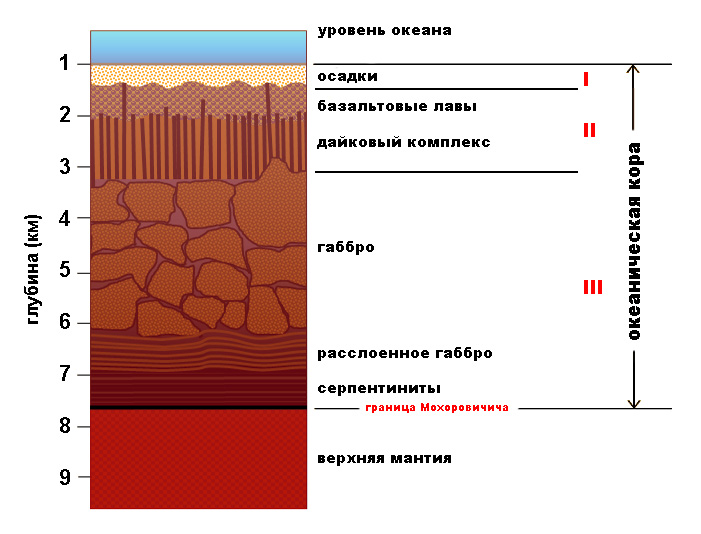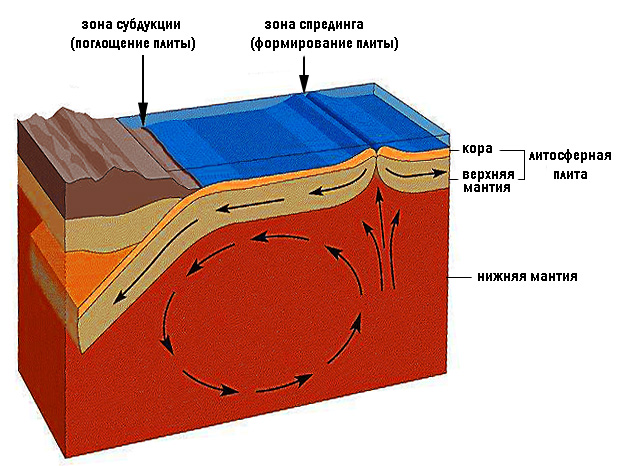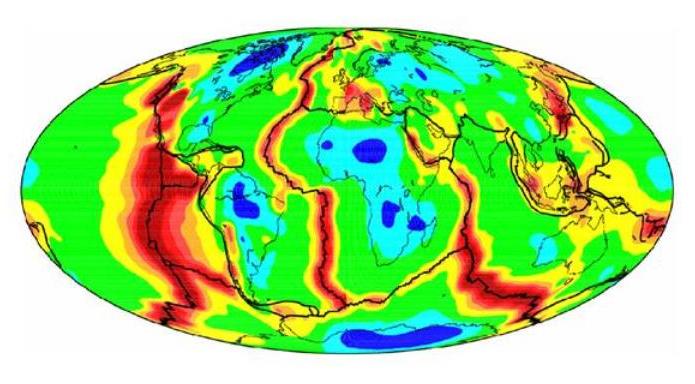A distinctive feature of the Earth's lithosphere associated with the phenomenon of global tectonics of our planet is the presence of two types of crust: the continental crust, which composes the continental massifs, and the oceanic. They differ in composition, structure, thickness and nature of the prevailing tectonic processes. An important role in the functioning of a single dynamic system, which the Earth represents, belongs to the oceanic crust. To clarify this role, first of all, it is necessary to turn to the consideration of its inherent features.
general characteristics
The oceanic type of crust forms the largest geological structure of the planet - the bed of the ocean. This crust has a small thickness - from 5 to 10 km (for comparison, the thickness of the continental-type crust averages 35–45 km and can reach 70 km). It occupies about 70% of the total Earth’s surface, but is almost four times as massive as the mainland crust. The average density of the rocks is close to 2.9 g / cm 3 , that is, higher than that of the continents (2.6–2.7 g / cm 3 ).
In contrast to the isolated blocks of the continental crust, the oceanic represents a single planetary structure, which, however, is not monolithic. The lithosphere of the Earth is divided into a series of movable plates formed by patches of the crust and the upper mantle underlying it. The oceanic type of crust is present on all lithospheric plates; there are plates (for example, Pacific or Nazca) that do not have continental arrays.
Plate tectonics and the age of the crust
Such large structural elements as stable platforms - thalassocratons - and active mid-ocean ridges and deep-sea trenches are distinguished in the oceanic plate. Ranges are areas of spreading, or spreading of plates and the formation of a new crust, and grooves are zones of subduction, or sub-movement of one plate under the edge of another, where the crust is destroyed. Thus, its continuous updating takes place, as a result of which the age of the oldest crust of this type does not exceed 160–170 Ma, that is, it formed in the Jurassic period.
On the other hand, it should be borne in mind that the oceanic type appeared on Earth earlier than the continental type (probably at the turn of the archaea-archaea, about 4 billion years ago), and is characterized by a much more primitive structure and composition.
What and how is the crust beneath the oceans
Currently, three main layers of the oceanic crust are usually distinguished:
- Sedimentary. It is formed mainly by carbonate rocks, partly by deep-sea clays. Near the slopes of the continents, especially near the deltas of large rivers, there are also terrigenous sediments entering the ocean from land. In these areas, the thickness of precipitation can be several kilometers, but on average it is small - about 0.5 km. Near the mid-ocean ridges, precipitation is practically absent.
- Basaltic. These are, as a rule, poured-out lava spilled, as a rule, under water. In addition, this layer includes the complex complex of dikes located below - special intrusions - dolerite (that is, also basalt) composition. Its average thickness is 2–2.5 km.
- Gabbro-serpentinite. It is composed of an intrusive analog of basalt - gabbro, and in the lower part - by serpentinite (metamorphosed ultrabasic rocks). The thickness of this layer, according to seismic data, reaches 5 km, and sometimes more. Its sole is separated from the underlying crust of the upper mantle by a special interface - the boundary of Mokhorovichich.

The structure of the oceanic crust indicates that, in essence, this formation can in some sense be considered as a differentiated upper layer of the earth's mantle, consisting of its crystallized rocks, which is overlain from above with a thin layer of marine sediments.
Ocean floor conveyor
It is clear why there are few sedimentary rocks in this crust: they simply do not have time to accumulate in significant quantities. Expanding from spreading zones in areas of mid-ocean ridges due to the influx of hot mantle matter during the convection process, lithospheric plates seem to carry the oceanic crust farther away from the place of formation. They are fascinated by the horizontal section of the same slow but powerful convective flow. In the subduction zone, the plate (and the crust in its composition) plunges back into the mantle already as the cold part of this stream. A significant part of the precipitation at the same time rips off, crumpled and ultimately goes to the growth of the continental-type crust, that is, to reduce the area of the oceans.

An oceanic type of crust has such an interesting property as strip magnetic anomalies. These alternating sections of direct and reverse magnetization of basalt are parallel to the spreading zone and are located symmetrically on both sides of it. They arise during the crystallization of basaltic lava, when it acquires residual magnetization in accordance with the direction of the geomagnetic field in a given era. Since it repeatedly experienced inversions, the direction of magnetization periodically changed to the opposite. This phenomenon is used for paleomagnetic geochronological dating, and half a century ago it served as one of the most compelling arguments in favor of the correctness of the theory of plate tectonics.
Oceanic type of crust in the cycle of matter and in the thermal balance of the Earth
Participating in the processes of tectonics of lithospheric plates, the oceanic crust is an important element of long-term geological cycles. Such, for example, is the slow mantle-oceanic water cycle. The mantle contains a lot of water, and a considerable amount of it enters the ocean when the basalt layer of the young crust is formed. But during its existence, the crust, in turn, is enriched due to the formation of a sedimentary layer by the water of the oceans, a significant proportion of which, partially in bound form, goes into the mantle during subduction. Similar cycles apply to other substances, such as carbon.

Plate tectonics plays a key role in the energy balance of the Earth, providing a slow transfer of heat from hot inner regions and heat transfer from the surface. Moreover, it is known that over the entire geological history the planet lost up to 90% of its heat precisely through the thin crust under the oceans. If this mechanism did not work, the Earth would get rid of excess heat in a different way - possibly, like Venus, where, as many scientists suggest, global crust destruction occurred when an overheated mantle breaks onto the surface. Thus, the importance of the oceanic crust for the functioning of our planet in a mode suitable for the existence of life is also extremely great.